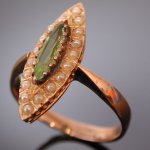We offer layaway, spread payments on the piece of your dreams. Ask us for details. Free insured shipping on all orders !!!

Antique jewelry glossary
Welcome to our extensive antique jewelry glossary with around 1,500 jewelry related entries.If you feel you are missing an explanation, feel free to let us know and we will add it.
A - B - C - D - E - F - G - H - I - J - K - L - M - N - O - P - Q - R - S - T - U - V - W - X - Y - Z all
Peridot

See our: Peridot jewelry.
Peridot is a gem variety of the golden-green mineral Olivine which has shades ranging from dark leek-green to yellowish-green (sometimes confused with green corundum, emerald and chrysoberyl). It is a magnesium iron silicate and one of the most common minerals on earth and has also been identified in (many) meteorites. Some examples are chatoyant.
The name 'peridot' is generally pronounced like the French form péridot; an alternative spelling 'peridote' is incorrect.
The original source in antiquity (for what still today is considered to be some of the finest gem-quality olivine) has been a body of mantle rocks on Egyptian Zabargad island (former St John's island) in the Red Sea.
The stones are usually faceted, but some are polished by tumbling or mounted in their natural rough form.
In Sri Lanka (formerly Ceylon) water-worn fragments of bottle-glass have been sometimes deceptively sold as peridot.
"Brown peridot", a stone of brownish color, has since 1952 been recognized as a different mineral, sinhalite.









